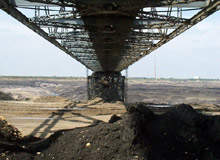
The most obvious hazards in a coal mine are the presence of gas and the threat of explosion, as well as floods in wet mines and structural collapse in particular unstable ones. But two other killers, less obvious and less cataclysmic, pose significant risks to mine workers. They are pollutants in the form of coal dust and diesel particulates from engine fumes.
Coal dust can, if not handled carefully, result in serious health issues, chiefly high concentrations of breathable coal dust, which can lead to pneumoconiosis – or ‘black lung disease’ – and silicosis from mining material with a high quartz content.
There are measures that mines can take such as ensuring workers wear masks and introducing engineering controls including ventilation dilution, water infusion, wet-cutting, water sprays, wetting agents and foam, and dust collectors such as dust scrubbers.
Better-than-expected results from recent tests of a dust scrubber at BHP Billiton Mitsubishi Alliance’s mine at Broadmeadow in Queensland’s Bowen Basin give hope for healthier mine environments. Scrubber systems have been tested before but success was limited by a lack of understanding of the dust and airflow patterns around the sites for dust control.
With the support of the Australian Coal Association Research Programme (ACARP), CSIRO has taken on several research projects based on computational fluid dynamics (CFD) modelling to improve the understanding of dust flow patterns around the longwall shearer and walkway under different operating conditions.
The new shearer scrubber system for dust control
The new shearer scrubber system trialled at Broadmeadow was developed by two of CSIRO exploration and mining division’s senior scientists, senior research engineer and project leader Dr Ting Ren and senior principal mining engineer Dr Rao Balusu, together with the environmental remediation company EnviroCon.
“The scrubber is a modular system consisting of an intake hood directed into the intake ventilation, a hydraulic-driven fan sucking the air into an impact filtration system and a discharge duct forcing the clean air under the shearer body towards the face,” Ren says.
A series of sprays was incorporated into the sides of the intake hood to create an agglomeration impact point for the dust/water mixture prior to impact filtration removal. These sprays were also designed to provide positive pressure resistance and create an ‘air curtain’ to stop dust entering the walkway and, secondly, to blow airborne dust out of the walkway.
“Cleansed air is discharged under the shearer ranging arm towards the face. The combined effect of the spray pressure, flow and design adds additional collection and dust behaviour modification to the system,” Ren says.
“We only had extremely confined space around the shearer and therefore the shearer scrubber has to be designed to fit and survive in such a harsh environment. We achieved this by incorporating innovative 3D CFD modelling studies and engineering designs.”
The mine commissioned Gillies Wu Mining Technology to establish the effectiveness of the longwall shearer scrubber in reducing dust at manned positions where shearer operators work during the cutting cycle. Four cycles were monitored with the first two undertaken by a day-shift crew and the second two by a night-shift crew.
Positive advances in mine safety
Monitoring results indicated that the dust reduction rate varied from 43% (with average dust concentration falling from 1.35mg/m³ to 0.77mg/m³) to 56% (with average dust concentration falling from 1.59mg/m³ to 0.70mg/m³).
The results were better than expected and indicated a positive advance in mine safety.
“We are making a great step in dust control, mostly coal dust, on longwalls by the installation and demonstration of this longwall shearer dust scrubber at Broadmeadow Mine,” Ren says.
“We are currently evaluating the effectiveness of the scrubber but our observation following its installation has been very encouraging and this has been endorsed by longwall operators at the mine. We have very positive feedback from the mine and the crew working on the longwall,” he adds.
“The scrubber will become an integrated part of their shear system and specific operating protocols will be implemented at the mine to ensure the system’s effectiveness.”
There is already strong interest being shown by other mines and more tests and refinements are due before the product can be commercialised.
This article first appeared in CSIRO’s magazine earthmatters.



